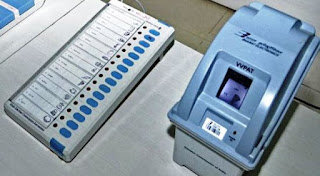Introduction of VPPAT – an appreciable decision of ECI above all doubts from political leaders and voters
The dark clouds of controversy over the use of Electronic Voting Machines – EVMs – during the elections, looks to be over with the use of VPPAT fitted with the machines.
Supreme Court through its judgment in 2013 has directed the Election Commission to complete this work in a systematic manner for use of EVMs during the Assembly and Parliament elections, duly fitted with VVPAT – Voter Verifiable Paper Audit Trail.
VPPAT is a method that provides feedback to voters. It is an independent verification printer machine and is attached to electronic voting machines. It allows voters to verify if their vote has gone to the intended candidate.
It is pertinent to mention that Mayawati – leader of Bahujan Samaj Party – BSP had particularly pointed out the misuse of tempering of EVMs during the Uttar Pradesh – UP elections to have favour in the elections.
Similarly, such issue was also raised by Arvind Kejriwal, AAP Supremo. Rather, he had submitted a written complaint to the Election Commission of India and protested in the Delhi Vidhan Sabha about the hacking of EVMs.
No doubt, the ECI had straightway rejected this charge and detailed discussions were also held on this burning issue by a good number of political parties during May this year. The only issue involved was the heavy cost expenditure to attach VVPAT equipment with the EVMs and around Rs.3,000 crore was demanded for the purpose.
Now the ECI had started to equip the existing EVMs with VVPAT apparatus to rule out any objection from any quarter or in other words to shut the mouth of critics on this point.
Everybody knows that bye-elections on seven Lok Sabha seats and Assembly elections by the end of this year are due in Gujarat and Himachal Pradesh and in Punjab on October 11 of next month in Gurdaspur.
In addition, two seats each in Rajasthan and JP and one each in Bihar and West Bengal are also due. In the next year, the Assembly elections in Rajasthan, MP, and Chattisgarh are also due.
BJP leader GVL Narasimha Rao, who is also a psychologist, had raised the possibility of voting machines getting manipulated a few years ago.
When AAP legislator Saurabh Bhardwaj demonstrated in the Delhi Assembly that manipulation at the booth level was possible, he was only raising an old doubt saying that the process is simple. The hacker presses the unique code that is the same as the voting machine’s software after he receives the bleep following voting and the machine stands rigged with the result all the votes will then go to one particular party.
This could have been an act of desperation from a party trying to save face after repeated poor performances in polls or just a tactic to divert attention from the recent turmoil in the party. However, it was such a problem that needs to be resolved to the satisfaction of all. The AAP is not the only party that has raised it, the BSP and the Congress have done it too. Whatever may be motive, idea or duress behind blaming the machines, the point is, it is the electoral process that finally gets a bad name.
The Election Commission without losing any time, on its part has clarified that the EVMs in Bhardwaj’s demonstration is a lookalike machine and not the type used in elections. Complex technical security features have been built into the Commission’s machines and these are backed by strict administrative protocol to prevent any tampering.
It had earlier clarified that the EVMs in India are different from those in use in foreign countries, especially on security parameters, and are tamper-proof. Bigger the controversy much is needed to be done at all levels.
The best way is to accept the challenge of the AAP and ask it to change the motherboard in 90 seconds to manipulate test voting and results. Besides, the idea was to find out any other loophole in the technological system which is condemned and needs to be plugged. It would not only settle the doubts over EVMs once for all but also save the commission from unnecessary criticism.
This is the reason; the ECI had asked the State Election Commissioners to take care of the arrangements accordingly. In fact, the elections in India – the with the largest democracy in the world – had been a challenging task.
The voting system has traveled the number of phases started from ballot papers and for some time booth-capturing and fake voting was a big problem but the EVM eradicated this menace in one go. Now when again the fingers started rising on the system, the addition of VVPAT has come before us, which is more fool-proof.
Frankly speaking, various countries have responded differently to the question of trustworthiness of EVMs. Germany has done away with the use of machines altogether as have Netherlands, Ireland, and Italy on the ground of transparency. Even countries like England and France have not clinched it notwithstanding pilot trials.
In some other countries, electronic voting is backed by paper ballots. Behind their action is the acknowledgment of the possibility, however remote, of rigging technology for the desired result. Any such action amounts to fraud on the voter, hence unacceptable.
Worldwide view is that computer chips control the machines which are susceptible to exploitation, they cannot be fully trusted
It is an admitted fact that India has one of the world’s best-conducted elections despite its geographical spread and vast population. This reputation should not be allowed to be sullied through motivated attacks. When it’s elections, even the theoretical possibilities need to be dealt with.
Anyhow, whatever may be the issue from any quarter, the Election Commission of India – ECI should be above all doubts from the political leaders and voters as well.
To be doubly sure, unconfirmed sources confirmed that the Election Commission has decided to count votes by machines as well as the manual way of counting the slips received from the VVPAT after polling.






